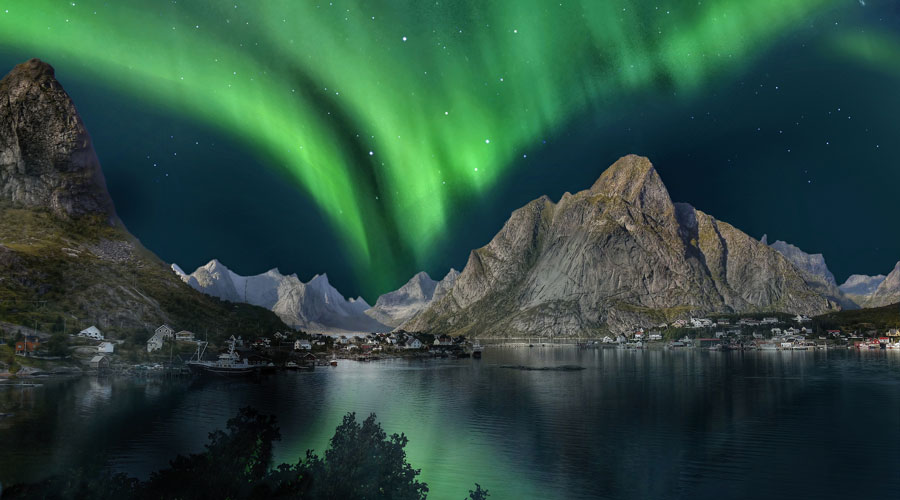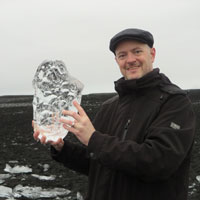
The elusive aurora borealis, aka the northern lights are an absolutely spectacular sight. If you're lucky enough to see them, you're definitely going to want to take photo. Here are a few Northern Lights photography tips for getting a great shot of this incredible natural light display.
Tripods
Regardless of the device you will be using, using a tripod will greatly increase the quality of any picture you take of the aurora borealis lights. Whether using a smartphone, digital point-and-shoot camera, or Digital Single-Lens Reflex (DSLR) cameras, a tripod stabilizes the device, and since you will be shooting in low light conditions, a longer exposure is required, meaning your lens will stay open longer, and even the slightest shaking will be noticeable. Iceland. Winter.
Quick tip: stay away from the carbon fiber tripods - they break easily when temperatures are low.
Batteries and power packs
It's a known fact that cold temperatures drain batteries at a faster rate than warm temperatures. When waiting for the northern lights to come out and play, keep devices as warm as possible, especially smartphones and point-and-shoot cameras, which can easily we slipped into pockets - body heat helps. It would also be a good idea to consider carrying extra batteries for your device, or a portable power bank.
No Flash!
To capture the aurora borealis, your goal is to be away from light pollution ... don't bring your own with you: turn off your flash, as it will wash out the northern lights display you are trying to capture.
iPhones/Smartphones
Newer smartphones are getting better at taking nighttime pictures, but whereas they can sometimes rival DSLR cameras in daytime photography, they still have a long way to go after the sun sets. Nevertheless, a few inexpensive apps are available for those shooting the aurora borealis with their smartphones. These three have good reviews:
- Cortex Camera Apple iOS/Android
- Northern Lights Photo Taker Apple iOS
- NightCap Pro Apple iOS
Given the number of apps being developed, and an increase in the number of people taking special trips to see the northern lights, there could certainly be more choices out there than the ones listed above. They will never replace a DSLR camera, but some will give you good enough quality shots as long as you use a tripod.
Point-and-Shoot Cameras
With a dizzying array of point-and-shoot (a.k.a. compact) cameras on the market, it is hard to encompass all the variables and settings that could be found on these devices. Regardless of the brand, know that your device's "Auto" mode is not your friend when it comes to photographing the northern lights - it triggers the flash, and the light pollution that it gives off will wash out your pictures of the northern lights ... and likely make people standing around you quite upset, as you will flash-blind them as well.
Some cameras make it pretty easy, offering Scene Modes such as "Starry Sky" or "Fireworks," which often do a good job. Newer point-and-shoot cameras tend to perform better, and those that offer a "Manual" setting (usually denoted by an M on the camera's setting wheel) will offer similar settings to those of DSLR Cameras (control over ISO, exposure time, etc.). Regardless of the settings your little point-and-shoot camera has, your shots will be blurry unless you use a tripod.
Digital Slow Lens Reflex (DSLR) Cameras Lenses
In today's DLSR world, the camera's body is almost less important than the lens. For the purposes of astrophotography, the kit (manufacturer's) lens that comes with your camera body will usually do just fine. However, some photographers prefer using wider lenses, as they capture more of the sky, which means capturing more of the grandeur of the aurora borealis. Some lenses are designed specifically for shooting at night, so a chat with your local camera expert could be in your future. It is a good idea to also bring lens wipes to remove moisture and frost from time to time.
Focus
Since the northern lights are at such a distance, setting your camera's lens to focus to infinity will be your first chore. Some lenses have an infinity symbol (∞), which will simplify everything; others require a little set-up, as described next.
Should you not know how to complete the following steps, you will need to refer to your user's manual, or a local camera expert. Use the "Live View Mode" of your camera and zoom in. Focus on the most distant point in your composition, as this is how you will know that you've set your lens to infinity. Make all the final adjustments manually and start testing your camera by taking a few shots with an aperture of f/2.8-f/3.5. Should you find that your test photos are below your expectations, simply repeat the previous steps. Once you've got it right, make sure that you keep the settings in place.
Camera settings
Now that you have set your focus, start working on how to best adjust your camera's settings. Depending on how bright the northern lights are, and how fast they're moving, the settings range from 30 second exposures at f/3.5 ISO 800 to 5 second exposures at f/2.8 ISO 3200. To minimize blur, increase the ISO and open up for only a few seconds.
(1) Image Format
DSLR cameras offer the option to shoot in the RAW and/or JPEG file formats. Depending on the capacity of the storage media you have, you might consider shooting in both or just RAW, while if your storage is limited, using JPEG may be a better idea. RAW will allow you to complete post editing in photo editing software (like Photoshop), and is a lossless way of capturing all the data gathered by your lens. JPEG, on the other hand, is a compressed file format that eliminates data redundancies (like a ZIP file) and removes what humans can't perceive (like an MP3).
(2) White Balance
Depending on the brightness of the northern lights, the ideal values for white balance in the K mode should be somewhere between 2800 and 4000. If shooting using the RAW file format, this can always be adjusted in post-editing software, but if shooting JPEG only, you'll likely need to take a few shots to get the right White Balance. Since each aurora borealis display is unique, your "best" setting will always be a moving target.
(3) Aperture
When it comes to nighttime photography, setting the aperture is quite easy. A suitable level is f/2.8. Anything above this value will only make it harder for you to capture a good landscape shot at night, although f/3.5 can still do a pretty good job of it.
(4) Exposure and ISO
These two go hand in hand, and both depend on the speed and the brightness of aurora borealis. Are the lights moving fast? Then a 5- to 7-second exposure should suffice. Are they moving slowly? Try a 25- to 30-second exposure time. More often than not, a 15- to 20-second exposure is a safe bet.
As far as the ISO is concerned, start by setting it between 400 and 800, and work your way up from there. ISO 400 will work well with bright, active displays only, but is usually not enough for less dynamic celestial shows. Increase the value as you go, until you reach the quality you are happy with. Going above ISO 3200 is usually not required, although ISO 3200 can come in handy if the northern lights aren't very bright, and lower settings show little more than a faded, almost wispy display.
When all else fails, you can always purchase a lovely set of postcards.

